The Effect of Organic Loading Rate Variation on Digestion of Tofu Wastewater using PVC Rings as Growth Media in a Hybrid UASB Reactor
Nyimas Yanqoritha1,2 , Muhammad Turmuzi1, Irvan1, Fatimah1 and Derlini2
, Muhammad Turmuzi1, Irvan1, Fatimah1 and Derlini2
1Department of Chemical Engineering, Universitas Sumatera Utara, Jalan Almamater Kampus USU, Medan, 20155, Indonesia.
2Department of Chemical Engineering, Institut Teknologi Medan, Jalan Gedung Arca 52, Medan, 20217, Indonesia.
Corresponding Author E-mail: irvan@usu.ac.id
DOI : http://dx.doi.org/10.13005/ojc/340361
Article Received on : October 30, 2017
Article Accepted on : January 16, 2018
Article Published : 22 May 2018
Tofu wastewater contains high organic matter potentially pollute the surrounding environment. An appropriate process for treating tofu wastewater is an anaerobic process which utilizes microorganisms in degrading organic matter in condition where dissolved oxygen contained in very small amount. Tofu wastewater treatment in this study using hybrid UASB reactor which its process is a process of incorporating suspended growth and attached growth process in one reactor. The hybrid UASB reactor is an attractive alternative technology for treating various types of wastewater. The Organic Loading Rate (OLR) is necessary parameter as an organic period per day per reactor cross section. This process was influenced by loading factor based on the value of HRT 6-24 h with range of organic load variation between 4.8-20.99 kgCOD m-3 d-1. The objective of OLR variation is to evaluate the reactor performance during process optimization. The highest COD removal efficiency was 85.57% on the 171th day for OLR 5.2 kgCOD m-3d-1 and HRT 24 h. The effluent quality deteriorated significantly when COD load increased and HRT decreased. This process shows the degradation of organic load requires HRT 24 h to reduce organic. This process shows that organic load degradation requires long HRT for streamlined treatment. Consequently, the optimal OLR for treating the tofu wastewater was up to 5.2 kgCOD m-3d-1 and HRT 24 h.
KEYWORDS:Tofu Wastewater; HUASB Reactor; OLR; COD Removal
Download this article as:| Copy the following to cite this article: Yanqoritha N, Turmuzi M, Irvan I, Fatimah F, Derlini D. The Effect of Organic Loading Rate Variation on Digestion of Tofu Wastewater using PVC Rings as Growth Media in a Hybrid UASB Reactor. Orient J Chem 2018;34(3). |
| Copy the following to cite this URL: Yanqoritha N, Turmuzi M, Irvan I, Fatimah F, Derlini D. The Effect of Organic Loading Rate Variation on Digestion of Tofu Wastewater using PVC Rings as Growth Media in a Hybrid UASB Reactor. Orient J Chem 2018;34(3). Available from: http://www.orientjchem.org/?p=46064 |
Introduction
According to data from Agency for Assessment and Application of Technology (BPPT), Indonesia has 84,000 tofu industries spread throughout its region. Production of tofu is hereditary business and mostly home scale industry. Total raw material consumption of tofu industries is about 256 million tons/year [1]. Waste generated from the manufacture of tofu mills is in the form of viscous liquid, separated from a clump of so-called whey water. Tofu wastewater has COD content in the range 7,520 – 11,450 mg/L which contains high content of protein [1]. Industrial tofu wastewater contains high organic matter which can contaminate to the environment. The appropriate process to treat tofu wastewater is anaerobic process. An anaerobic process is a biological process that utilizes microorganisms in degrading organic matter under no or very little dissolved oxygen [1]. Anaerobic processes are grouped by suspended growth processes and embedded growth processes. One of the reactors using the growth of suspended microorganisms is the upflow anaerobic sludge blanket (UASB). Anaerobic process with UASB reactor gives the advantage to be applied commercially and the effluent can fulfil the standard regulation of Indonesian government. The characteristics of UASB reactor are capable of operating at very high load rates with sludge produced easily settled, high biomass concentrations (30,000-80,000 mg/L) and excellent solid and liquid separations [2].
The UASB reactor has been developed which known as the hybrid UASB reactor. The Hybrid UASB reactor is an improved version of the UASB system that combines with fixed film reactors [3]. The Hybrid UASB reactor is an appealing technology for processing such as sago, tofu, refinery, starch, and milk wastewater. Hybrid reactors seem to be better at reducing organic loads with optimum HRT 10 – 20 hours [3].
In sago industry, anaerobic technology using the hybrid UASB reactor is an effective method to treat its waste with COD removal up to 95%, with production of methane[3]. The hybrid UASB reactor can support higher concentration of biomass than UASB reactor, because hybrid UASB reactor has supporting media as attached system in hybrid UASB reactor[4].
The acclimatization process in the processing of tofu wastewater using hybrid UASB reactor, bacteria started to work on the 50th day, shown by the formation of biogas and efficiency of COD removal of 67.21% [5]. Reduction of organic load about 87.35% in refinery waste treatment [6]. Then, Process on the hybrid UASB reactor is preferable compared with the UASB reactor for processing of starch waste with elimination of organic load about 83.10% [4].
In operational conditions, OLR was parameter that may affect the condition of the process and must be controlled [4,7]. In processing milk wastewater with OLR until 8.9 kg.m-3 d-1 [8], reduction of COD could reach at 93%. Increasing organic load provides modification of granular structure and loss of stability. The increasing of OLR leads the decreasing of volatile solid and biogas production[9,10]. Organic loading level that grow in the appropriate range can improve biogas production, then if OLR level is in the over range, it can cause system instability[11].
This research goal is to study the influence of OLR variation on biogas production and COD removal in a hybrid UASB reactor using PVC rings as growth media of tofu wastewater treatment.
Materials and Methods
Reactor HUASB
Figure 1 shows lab scale of the hybrid UASB reactor. The hybrid UASB reactor was designed similar to the previous research[5], which consists of suspended sludge blanket reactor, attached media and gas liquid solid separator (GLSS). Operating volume of the reactor is 8.6 litres. Average precipitation velocity (Vup) is 0.08 – 0.33 m/h. This reactor used polyvinyl chloride (PVC) ring as support media. The system has four sample media ports suspended at the bottom of the reactor and four port sampling attached at the top of the reactor. Tofu wastewater is inserted as an inlet and excess sludge. Then continue to flow as a process that came out through outlet to the clarifier as a waste tank. Tofu wastewater without further pre treatment was fed into the reactor through inlet pipe by the peristaltic pump. Packaging media as filter used in this study is a PVC carrier.137 pieces of PVC rings were used as attached growth media of the same size which has has an area of approximately 50 cm2. Reactor was equipped with a glss to separate effluent which increasing due to the movement of the feed [5].
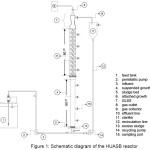 |
Figure 1: Schematic diagram of the HUASB reactor |
Sample Collection
Tofu wastewater was obtained from one of the tofu mills in Medan, North Sumatera, Indonesia. Industrial waste water tofu contained chemical oxygen demand 60,000 mg/L and pH was at 5. NaHCO3 and K2HPO4 were added to tofu wastewater to prevent pH fluctuation.
Analytical Procedure
During the operation of reactor, the parameter that affect the process are monitored daily, such as pH, temperature, gas production dan COD. The whole determination were operated in according to Standard Methods by American Public Health Association (APHA) [12].
Results and Discussions
OLR is one of the parameters that affect the process of wastewater treatment. In this experiment, amount of OLR fed into the reactor was based on the values of HRT (24, 18, 12, and 6 h). After the start-up, the OLR of the hybrid UASB reactor were varied from 4.8 to 20.99 kg COD m-3 d-1. The objective of organic load variation is to consider accomplishment of the reactor during process optimization. The Hybrid UASB reactor was operated until a stable condition was reached so that the gas production and COD removal were constant for each OLR.
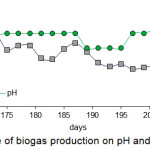 |
Figure 2: Profile of biogas production on pH and days operation |
Biogas production during the process for different pH is shown in figure 2 which shows the highest biogas production at 1510 mL and pH 7.8. Removal of COD 85.57% at pH 7.8 in Fig 3. In Fig 4, the process was carried out at the lowest OLR up to the highest 4.8 to 20.99 kg COD m-3 d-1.
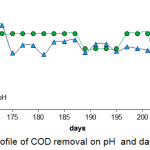 |
Figure 3: Profile of COD removal on pH and days operation |
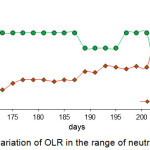 |
Figure 4: The variation of OLR in the range of neutral pH (6.5-7.8) Click here to View figure |
The level of OLR during the process affects the production of biogas. At the loading rate of 5.2 kg COD m-3 d-1biogas production 1510 mL, OLR 7.2 kg COD m-3 d-1 biogas production 970 mL, OLR 10.64 kg COD m-3 d-1 biogas production 900 mL, OLR 19.28 kg COD m-3 d-1 biogas production 644 mL, OLR 20.99 kg COD m-3 d-1biogas production 875 mL (see fig 5). Accordingly the optimum OLR is shown at 5.2 kg COD m-3 d-1 and biogas production about 1510 mL at pH 7.8. This shows that at load rate at 5.2 kg COD m-3 d-1has longer contact time so that the degradation of organic compound takes more result in HUASB process of methanogenic bacteria more active. It is shown that pH effluent is at 7.8 which is the methanogenic phase bacteria. Methanogens prefer a nearly neutral pH condition with generally accepted optimum ranges of about 6.5 to 8.0 and 6.5 to 8.2, respectively [2,13].
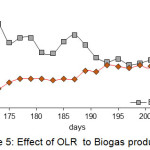 |
Figure 5: Effect of OLR to Biogas production |
Biogas production during the hybrid UASB reactor operates at various OLRs is shown in Figure 5. Maximum biogas production is obtained 1510 mL on the 171th day at OLR 5.2 kgCOD m-3d-1. The increase in OLR significantly decreases gas production. This process shows that acidification microorganisms apply to methanogens that can lead to the accumulation of essential fatty acids [9].
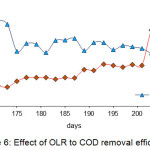 |
Figure 6: Effect of OLR to COD removal efficiency |
Figure 6 shows the maximum COD removal efficiency of the hybrid UASB reactor is 85.57% on the 171th day at OLR 5.2 kg COD m-3d-1, when the HRT was 24 h. During this period, the effect of higher OLR levels provided by lowering HRT was evaluated. The effluent quality deteriorated significantly when the influent COD increased and HRT decreased, corresponding to the OLR between 4.8-5.2 kg COD m-3d-1. This process indicates that short HRT (6 h) results in poor COD removal efficiency (43-53%), where as HRT (24 h) produces the maximum removable COD removal of 85.57%.The increase in OLR leads to a gradual decrease in COD removal efficiency [14,15]. This process shows that organic load degradation requires long HRT for streamlined treatment. Consequently, the optimal OLR for treating the tofu wastewater was up to 5.2 kgCOD m-3d-1 and HRT 24 h.
Conclusion
Increased biogas yield and COD removal efficiency are affected by the OLR in the right range.The optimal organic loading rates (OLR) for treating the tofu wastewater was up to 5.2 kgCOD m-3d-1 and HRT 24 h. The highest COD removal efficiency was 85.57% and biogas production 1510 mL on the 171th.
Acknowledgments
The author’s would like to acknowledge the research that the financial support from Kemenristekdikti on Research Product Applied (PPT) 2017, Institute Technology Medan (ITM) and Departement of Chemical Engineering of Doctor Program of Universitas Sumatera Utara.
References
- BPPT, “Analysis of Existing Condition for Biogas Technology Implementation in Tofu Wastewater Treatment, ”Renewable Energy-Efficiency Energy Partnership (REEEP) Environmental Tech. Centre, The Agency for the Assessment and App. of Tech., (2013).
- Speece, R.E. “Biomass Immobilization,” Vanderbilt University,144-1158, (1996).
- Doraisamy, P., Nandakumar, N. B., Maheswari,M., Selvamurugan, M., Clean Tech. Environ. Policy, 15, 391–394, (2013).
CrossRef - S. Govindaradjane, T. Sundarajan, Int. J. of Eng. Adv. Tech., 2(4),55-64 (2013).
- Yanqoritha, N., Turmuzi, M., Derlini, AIP Conf. Proceedings, Published by the American Institute of Physics, 1840, 110013(1)-110013(7), (2017).
- Sridevi, K., Sivaraman, E., Mullai, P., Bioresource Tech, 165, 223-240, (2014).
CrossRef - Li, Y. F., Abraham, C., Nelson, M.C., Chen, P.H., Graf, J., Yu, Z, Environmental Biotechnology, 99, 8777-8792, (2015).
CrossRef - Gomes, D. R. S., Papa, L.G., Cichello, G.C.V., Belancon, D., Pozzi, E.G., Balieiro, J.C.C., Monterrey, E.S., Tommaso, G., Desalination, 279, 96-103, (2011).
CrossRef - Babaee, A., Shayegan, J., Bioenergy Tech (BE), World renewable energy congress Sweden, 411-417, (2011).
- Adebayo, A.O., Jekayinfa, S. O., Linke, B., British J. of Applied Science & Tech., 11(4), 1-9, (2015).
CrossRef - Sun, M.T., Fan, X. X., Zhao, X. X., Fu, S. F., Guo, R. B. , Bioresource Tech., 235, 292-300, (2017).
CrossRef - APHA, Standard Methods for the Examination of Water and Wastewater 22nd ed, edited by Eugene W.,Rodger B.,Andreww D.,Lenore S.(American Public Health Association, Washington, DC, (2012).
- Dobre, P., Nicole, F., Matei, F., Romanian Biotechnological Letters, 19(3), 9283-9296, (2014).
- Banu, J.R., Kaliappan, S., J. of Environmental Eng. and Science, 6, 415-421, (2007).
CrossRef - Li, W., Su, C., Liu, X., Zhang, L., Environ. Sci. Pollut. Res, 21, 8167-8175, (2014).
CrossRef

This work is licensed under a Creative Commons Attribution 4.0 International License.









